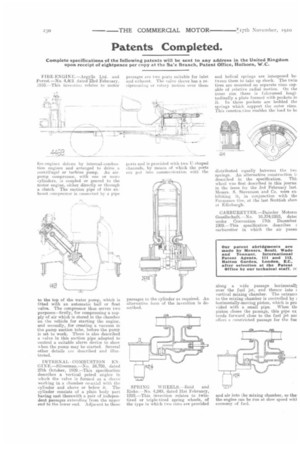Patents Completed.
Page 22

If you've noticed an error in this article please click here to report it so we can fix it.
Complete specifications of the following patents will be sent to any address in the United Kingdom upon receipt of eightpence per copy at the Sa'e Branch, Patent Office, Holborn, W.C.
FIRE-ENGINE.—Argylls Ltd. and Perrot,—No. 4,4(9, dated 23rd February, 1910.--This invention relates to motor
fireengines driven by internal-combustion engines and arranged to drive a centrifugal or turbine pump. An airpump compressor, with one or more cylinders, is coupled or geared to the motor engine, either directly or through a clutch. The suction pipe of this exhaust compressor is connected by a pipe to the top of the water pump, which is fitted with an automatic ball or float valve. The compressor thus serves two purposes—firstly, for compressing a supply of air which is stored in the chamber on the vehicle for starting the engine, and secondly, for creating a vacuum in the pump suction tube, before the pump is set to work. There is also described a valve in this suction pipe adapted to control a suitable alarm device to show when the pump may be started. Several other details are described and illustrated.
INTERNAL 00111311.3STION ENCINE.—Silverman.—No. 24,708, dated 27th October, Mg.—This specification describes a vertical petrol engine in which the valve is formed as a sleeve working in a chamber co-axial with the cylinder and above or below it. The cylinder consists of a plain body part having cast therewith a pair of independent passages extending from the upper end to the lower end. Adjacent to these
passages are two ports suitable for inlet and exhaust. The valve sleeve has a reciprocating or rotary motion over these
ports and is provided with two U-shaped channels, by means of which the ports are put into communication with the
passages Lu the cylinder as required. An alternative form of the invention is desot ibed.
SPRING WIIEELS.—Reid and Rieke.—No. 4,249, dated 21st February, 1910.—This invention relates to twintired or triple-tired spring wheels, of the type in which two rims are provided and helical springs are interposed between them to take up shock. The twin tires are mounted on separate rims capable of relative radial motion. On the inner rim there is fulcrnmed longitudinally a plate formed with pockets in it. In these pockets are bedded the springs which support the outer rims. This construction enables the load to be
distributed equally between the twc springs. An alternative construction li described in the specification. Thig wheel was first described in this journa in the issue for the 3rd February last Messrs. S. Stevenson and Co. were exhibiting it, in conjunction with the Faiansure tire, at the last Scottish show at Edinburgh.
CARBURETTER.—Daimler Motorw Gesellschaft.—No. 10,374/1910, datee under Convention 17th December. 1909.—This specification describes carburetter in which the air passe:
along a wide passage horisontaTh over the fuel jet, and thence into t vertical mixing chamber. The entraneg LO the mixing chamber is controlled by 4 horizontally-moving piston, which is pro vided with a small pipe. When thg piston closes the passage, this pipe ex tends forward close to the fuel jet ant offers a constricted passage for the fue
and air into the mixing chamber, so Oa the engine can be run at. slow speed witl economy of fuel.






















